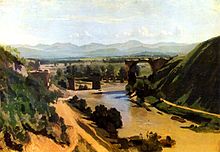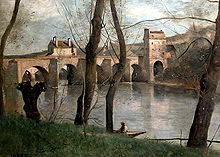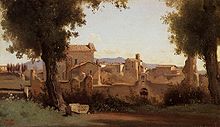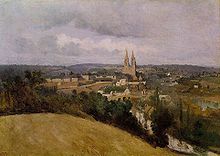- Jean-Baptiste Camille Corot
-
 Camille Corot, Fotografie von Nadar
Camille Corot, Fotografie von Nadar
Jean-Baptiste Camille Corot (* 16. Juli 1796 in Paris ; † 22. Februar 1875 ebenda) war ein bedeutender französischer Landschaftsmaler. Er ist einer der Hauptvertreter der Schule von Barbizon.
Inhaltsverzeichnis
Leben
Camille Corot stammte aus gutbürgerlichen Verhältnissen. Seine Mutter war eine erfolgreiche Modistin. In Paris geboren, lebte er zunächst bei einer Amme auf dem Land. Nach dem Besuch eines Pariser Pensionats besuchte er das Gymnasium in Rouen und absolvierte eine Lehre als Tuchhändler. Mit 26 Jahren gab er die ungeliebte Geschäftstätigkeit auf und schlug die Künstlerlaufbahn ein. Er wurde Schüler von Jean-Victor Bertin, einem Hauptvertreter der klassischen Landschaftsmalerei. 1825 reiste er nach Rom und malte für drei Jahre in der Campagna Romana. Zurück in Paris, bezog er ein Atelier in der Rue Voltaire. Er begab sich auch auf Fußreisen durch Frankreich, den Niederlanden und der Schweiz.
Ab 1827 nahm er regelmäßig am Pariser Salon teil. 1846 erhielt er das Kreuz der Ehrenlegion, 1867 wurde er zum Offizier ernannt. Corot ist auf dem Pariser Friedhof Père Lachaise beigesetzt.
Sein wohl bedeutendster Schüler war Camille Pissarro.
Leistung
Corot fand in Italien zu seiner Landschaftsmalerei mit freier, aber straffer Komposition und gedämpfter Farbigkeit, die er nach 1850 zu einer reinen Stimmungsmalerei weiterentwickelte. Corot war einer der Hauptvertreter der Schule von Barbizon, der u. a. auch Théodore Rousseau, Charles-François Daubigny und Jean-François Millet angehörten. In seinen späten Jahren war er als Père Corot die Vaterfigur der Pariser Kunstszene und galt als der führende Landschaftsmaler Frankreichs. Zu seinen Zeitgenossen zählen Meindert Hobbema, William Turner und John Constable. Neben der Landschaftsmalerei schuf Corot auch Frauenbildnisse.
Corot hatte die Entwicklung des Impressionismus entscheidend beeinflusst. Etliche bekannte Maler beriefen sich auf Corot oder bezeichneten sich als seine Schüler, etwa Eugène Boudin, Stanislas Lepine, Antoine Chintreuil, François-Louis Français, Berthe Morisot, Charles Le Roux und Barthélemy Menn.
Werke
- Brücke von Narni – Augustusbrücke über die Nera (Paris, Musée du Louvre), 1826, Öl auf Leinwand, 34 × 48 cm
- Colosseum und Farnese-Gärten in Rom (Paris, Musée du Louvre), 1826, Öl auf Leinwand, 30,5 × 48 cm
- Die Albanerin (L’Albanaise) ausgestellt in New York im Brooklyn Museum
- Forum und die Farnese-Gärten in Rom (Paris, Musée d´Orsay), 1826, Öl auf Leinwand, 28,8 × 50,4 cm
- Castelgandolfo (Budapest, Szépművészeti Múzeum), um 1826, Öl auf Leinwand, 36,3 × 28,3 cm
- Frau mit Mandoline (Paris, Privatsammlung), 1826-28, Öl auf Leinwand, 34 × 26 cm
- Italienerin mit Krug (Paris, Privatsammlung), 1826-28, Öl auf Leinwand, 23 × 30 cm
- Honfleur – Kalvarienberg auf der Côte de Grâce (Paris, Sammlung Renand), um 1830, Öl auf Leinwand, 30 × 42 cm
- Wald von Fontainebleau (Paris, Sammlung Renand), 1830-35, Öl auf Leinwand, 48 × 59 cm
- Hütten mit Mühle am Bachufer (Paris, Musée Cocnacq-Jay), 1831, Öl auf Leinwand, 53 × 54 cm
- Porträt der Octavie Sennegon (Paris, Sammlung Renand), 1833, Öl auf Leinwand, 35 × 29,5 cm
- Stadt und See von Como (Paris, Sammlung Peytel), 1834, Öl auf Leinwand, 29,5 × 42 cm
- Ansicht von Genua (Chicago, Art Institute), 1834, Öl auf Leinwand
- Morgen in Venedig (Moskau, Puschkin Museum), 1834, Öl auf Leinwand, 27 × 40 cm
- Blick vom Giardino di Boboli auf Florenz (Paris, Musée du Louvre), nach 1834, Öl auf Leinwand, 51 × 73,5 cm
- Sitzende Frau mit entblößter Brust (Paris, Sammlung Renand), um 1835, Öl auf Holz, 24 × 18,5 cm
- Hagar in der Wüste (Paris, Sammlung Renand), 1835, Öl auf Leinwand, 41 × 3 cm
- Ansicht von Villeneuve-Lés-Avignon (Reims, Musée des Beaux Arts), 1836, Öl auf Leinwand, 38,3 × 56 cm
- Avignon aus Westen (London, National Gallery), 1836, Öl auf Leinwand, 34 × 73,2 cm
- Porträt Madame Charmois (Paris, Musée du Louvre), 1837, Öl auf Leinwand, 43 × 35 cm
- Château de Rosny (Paris, Musée du Louvre), 1840, Öl auf Leinwand, 24 × 35 cm
- Madame Legois (Wien, Österreichische Galerie, Inv. Nr. 2413), um 1840-45, Öl auf Leinwand, 55 × 40 cm
- Bretoninnen am Brunnen (Paris, Musée du Louvre), 1842, Öl auf Leinwand, 33 × 25 cm
- St-André-en-Morvan (Paris, Musée du Louvre), 1842, Öl auf Leinwand, 31 × 59 cm
- Der Nemisee (Wien, Österreichische Galerie, Inv. Nr. 3149), 1843, Öl auf Leinwand
- Marietta - Die römische Odaliske (Paris, Musée du Petit Palais), 1843, Öl auf Papier, 29,3 × 44,2 cm
- Porträt Louis Robert als Kind (Paris, Musée du Louvre), 1843-44, Öl auf Leinwand, 27 × 22 cm
- Lesendes Mädchen in rotem Trikot (Zürich, Sammlung Bührle), 1845-50, Öl auf Leinwand
- Une Matinée (Paris, Musée du Louvre), 1850
- Tanz der Nymphen (Paris, Musée du Louvre), um 1850, Öl auf Leinwand
- La Rochelle, Hafeneinfahrt (Paris, Sammlung Renand), 1851, Öl auf Holz, 27 × 40 cm
- Heuwagen (Moskau, Puschkin-Museum), 2. Drittel 19. Jahrhundert, Öl auf Leinwand, 32 × 45 cm
- Stürmisches Wetter - Ufer des Pas-de-Calais (Moskau, Puschkin-Museum), 2. Drittel 19. Jahrhundert, Öl auf Leinwand, 39 × 55 cm
- Waldeingang bei Ville d’Avray (Edinburgh, National Gallery of Scotland), 2. Drittel 19. Jahrhundert, Öl auf Leinwand, 46 × 35 cm
- Porträt der Oberin des Annunziaten-KLosters in Boulogne-sur-mer (Paris, Musée du Louvre), 1852, Öl auf Holz, 36 × 23 cm
- Ruelle d’un village (Dardagny (New York, Metropolitan Museum of Art), 1853
- Weg nach Sévres (Paris, Musée du Louvre), 1855-65, Öl auf Leinwand, 34 × 49 cm
- Macbeth (London, Wallace Collection), 1859
- Mädchen im Grünen (Genf, Musée d’art et d’histoire), 1859, Öl auf Leinwand, 49 × 75 cm
- Kathedrale von Nantes (Reims, Musée des Beaux Arts), um 1860, Öl auf Leinwand, 42,7 × 55,8 cm
- Kathedrale von Nantes (Reims, Musée des Beaux Arts), nach 1860, Öl auf Holz, 52,1 × 32,6 cm
- Erinnerung an Pierrefonds (Moskau, Puschkin-Museum), 1860-61, Öl auf Leinwand, 46 × 38 cm
- Le Lac (Glasgow, Corporation Art Gallery), 1861
- Orpheus geleitet Eurydike aus der Unterwelt (Houston, Museum of Fine Arts), 1861, Öl auf Leinwand, 112,3 × 137,1 cm
- Erinnerung an Mortefontaine (Paris, Musée du Louvre), 1864, Öl auf Leinwand, 65 × 89 cm
- L’Arbre brisé (Glasgow, Corporation Art Gallery), 1865
- Atelier des Künstlers (Paris, Musée du Louvre), 1865-66, Öl auf Leinwand, 56 × 46 cm
- Der Brief (New York, Metropolitan Museum of Art), um 1865, Öl auf Holz, 54,6 × 36,2 cm
- La Zingara (Paris, Musée du Louvre), 1865-70, Öl auf Leinwand, 54 × 38 cm
- Rast unter Weiden am Wasser (Paris, Musée du Louvre), 1865-70, Öl auf Leinwand, 45 × 60,5 cm
- Jeune femme aux puits, bisher Otterlo, Kröller-Müller-Museum, 1865-1870
- Agostina, die Italienerin (Washington, National Gallery of Art), 1866, Öl auf leinwand, 138,6 × 95 cm
- Erinnerung an Marissel (Paris, Musée du Louvre), 1866, Öl auf Leinwand, 55 × 42 cm
- Frau mit Margeriten (Budapest, Szépművészeti Múzeum), 1868-70, Öl auf Leinwand, 78 × 58 cm
- Lesende Frau (New York, Metropolitan Museum of Art), 1869-70, Öl auf Leinwand, 54,3 × 37,5 cm
- Landschaft bei Castelgandolfo (Paris, Musée du Louvre), um 1870, Öl auf Leinwand
- Glockenturm von Douai (Paris, Musée du Louvre), 1871, Öl auf Leinwand, 46,5 × 38,5 cm
- Erinnerung an Coubron (Budapest, Szépművészeti Múzeum), 1872, Öl auf Leinwand, 46 × 55,3 cm
- Pastorale - Souvenir d’Italie (Glasgow, Corporation Art Gallery), 1873
- Straße in Sin-Le-Noble (Paris, Musée du Louvre), 1873, Öl auf Leinwand, 60 × 81 cm
- Teich von Ville-d’Avray (Rouen, Musée des Beaux Arts), 1873, Öl auf Leinwand, 43 × 80 cm
- Frau in Blau (Paris, Musée du Louvre), 1874, Öl auf Leinwand, 80 × 51 cm
- Inneres der Kathedrale von Sens (Paris, Musée du Louvre), um 1874, Öl auf Leinwand, 61 × 40 cm
Literatur
- Felix Baumann (Hrsg.): Sehnsucht Italien. Corot und die frühe Freilichtmalerei 1780-1850. Edition Braus, Heidelberg 2004, ISBN 3-89904-104-6 (Ausstellungskatalog)
- Camille Corot: Briefe aus Italien. Klinkhardt & Biermann, Leipzig 1924.
- Dario Durbé u.a.: Corot und die Schule von Barbizon. Pawlak, Herrsching 1988, ISBN 3-88199-430-0-
- Peter Galassi: Corot in Italien. Freilichtmalerei und klassische Landschaftstradition. Hirmer, München 1991, ISBN 3-7774-5490-7.
- Johannes Greiner u.a.: Jean Baptiste Camilles Corot (1796-1875). Ein multimedialer Wegweiser zur Kunst. Krick Fachmedien, Würzburg 2000, ISBN 3-89694-855-5 (1 CD-ROM)
- Jean Leymarie: Corot. Biographisch-kritische Studie. Skira-Klett-Cotta, Genf 1980, ISBN 3-88447-049-3.
- Heinrich Lützeler (Vorw.): Hundert Graphische Blätter des XIX und XX Jahrhunderts. Stiftung des Vereins der Freunde und Förderer des Städtischen Gymnasiums Brühl, Kleve 1966.
- Vincent Pomarède: Corot. Flammarion, Paris 1996, ISBN 2-08-012123-5.
- Leonhard Saint-Michel: Corot und seine Welt. Gondrom, Bayreuth 1981. ISBN 3-8112-0216-2.
- Yvon Taillandier: Corot. Flammarion, Paris 1990, ISBN 2-08-011554-5.
Weblinks
 Commons: Jean-Baptiste Camille Corot – Album mit Bildern und/oder Videos und AudiodateienKategorien:
Commons: Jean-Baptiste Camille Corot – Album mit Bildern und/oder Videos und AudiodateienKategorien:- Französischer Maler
- Landschaftsmaler
- Mitglied der Ehrenlegion
- Geboren 1796
- Gestorben 1875
- Mann
Wikimedia Foundation.





